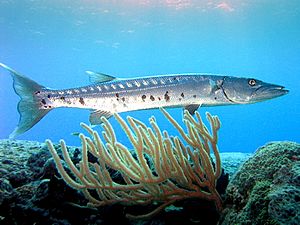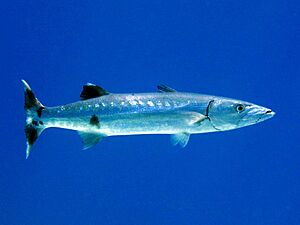Great barracuda facts for kids
Quick facts for kids Great barracuda |
|
|---|---|
 |
|
| Great barracuda hovering in the current at Paradise Reef, Cozumel, Mexico | |
| Conservation status | |
| Scientific classification | |
| Synonyms | |
|
List
Sphyraena barracuda Walbaum, 1792
Agrioposphyraena barracuda (Walbaum, 1792) Esox barracuda Walbaum, 1792 Esox barracuda Edwards, 1771 Sphyraena becuna Lacepède, 1803 Sphyraena commersonii Cuvier, 1829 Sphyraena dussumieri Valenciennes, 1831 Sphyraena picuda Bloch & Schneider, 1801 Sphyraena sphyraena picuda Bloch & Schneider, 1801 |
The great barracuda (Sphyraena barracuda), also called the giant barracuda, is a large, fast-swimming fish found in warm oceans worldwide. It's a type of barracuda, known for being a skilled hunter. These fish are powerful predators that live in subtropical waters.
Contents
Where Great Barracudas Live
The great barracuda lives in warm parts of the Indian Ocean, Pacific Ocean, and Atlantic Ocean. You can find them in many places, from areas with mangrove trees to deep coral reefs. They can live as deep as 110 meters (about 360 feet) underwater.
Scientists have noticed that the number of great barracudas might be going down in Florida. Because of this, people in Florida are thinking about setting limits on how many can be caught.
What Great Barracudas Look Like
Great barracudas are big fish! Most grown-up barracudas are about 60 to 100 centimeters (2 to 3 feet) long. They usually weigh between 2.5 and 9 kilograms (5.5 to 20 pounds).
Some very large barracudas can be over 1.5 meters (5 feet) long and weigh more than 23 kilograms (50 pounds). The biggest one ever caught with a fishing rod weighed 46.72 kilograms (103 pounds) and was 1.7 meters (5.6 feet) long. Even longer ones have been seen, up to 2 meters (6.6 feet) long! The very largest can grow up to 3 meters (10 feet).

Great barracudas are blue-gray on top and turn silvery-white underneath. Sometimes, they have dark stripes on their upper sides and black spots on their lower sides. Their back fin, bottom fin, and tail fin can be dark purple to black with white tips.
Body Features
Barracudas have long, thin bodies with strong jaws. Their lower jaw sticks out further than their upper jaw. They have sharp, fang-like teeth of different sizes. These teeth are set firmly in their jaws and on the roof of their mouth.
Their head is quite large and looks pointed, a bit like a pike fish. The covers over their gills are smooth and covered with small scales. They have two dorsal fins (back fins) that are far apart. The first dorsal fin has five stiff spines. The second dorsal fin has one spine and nine soft rays. This second dorsal fin is about the same size as their anal fin (bottom fin) and is located right above it.
A clear line, called the lateral line, runs straight from their head to their tail. This line helps them sense movements in the water. Their tail fin is forked or curved inward, and it's attached to a strong, thick part of their body. Their pectoral fins (side fins) are placed low on their sides. Barracudas also have a large swim bladder, which helps them control their depth in the water.
Barracuda Behavior and Life Cycle
Great barracudas live in open ocean waters. They are very fierce predators and hunt by surprise. They hide and then use short bursts of speed, up to 43 kilometers per hour (27 mph), to catch their prey. They are not very good at quick turns, but their speed makes up for it.
Adult barracudas usually live alone. However, young and half-grown barracudas often swim together in groups called shoals.
Life Cycle and Diet
Barracudas can live for at least 14 years. They lay their eggs during a spawning season that lasts from April to October. A female barracuda can release a huge number of eggs, from about 5,000 to 30,000!
These top predators mostly eat other fish and cephalopods (like squid). Sometimes, they also eat shrimp. Large barracudas, after they have eaten a lot, might try to gather a school of prey fish in shallow water. They then guard these fish until they are ready to hunt again.
Barracudas and Humans
Barracudas are known to be scavengers, meaning they sometimes eat leftover food. They might follow snorkelers because they mistake them for large predators that could leave behind food.
It's rare for barracudas to bite humans. When it does happen, it's often because the water is cloudy, or the barracuda mistakes something shiny for prey. Bites can cause cuts and some tissue loss, but they are not common.
Barracudas are popular with people who like to fish for fun. This is because they put up a strong fight when they are caught. However, they can release a strong smell when caught. Also, eating barracuda meat can sometimes cause a type of food poisoning called Ciguatera fish poisoning.
Images for kids
-
School of great barracudas in the Red Sea.
See also
 In Spanish: Sphyraena barracuda para niños
In Spanish: Sphyraena barracuda para niños




